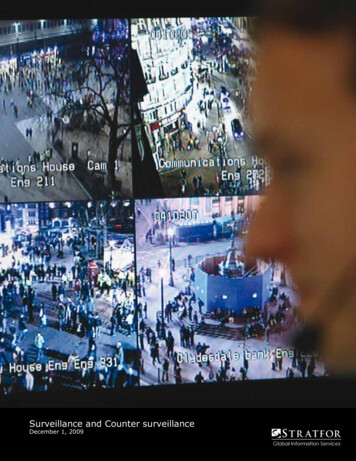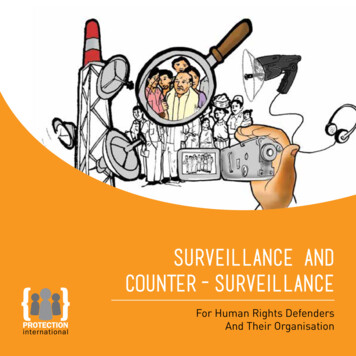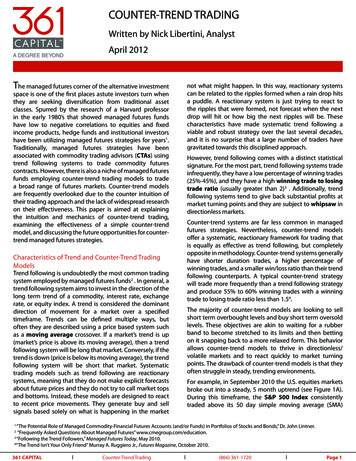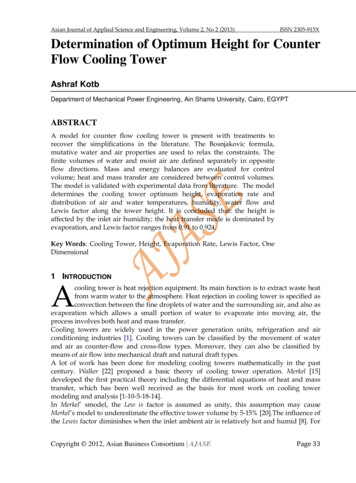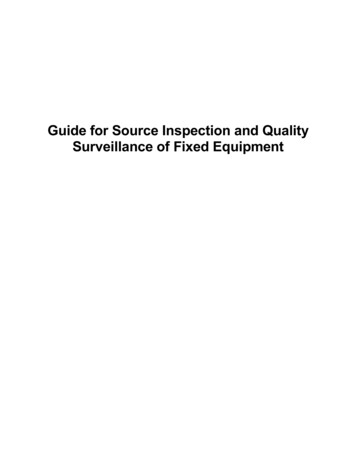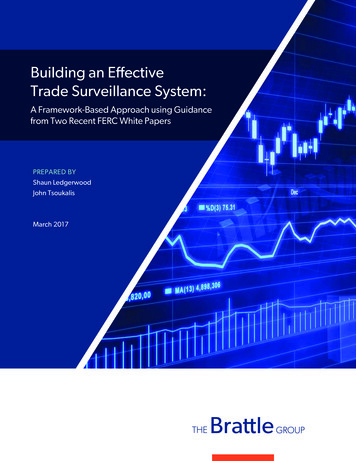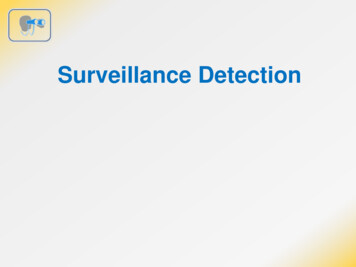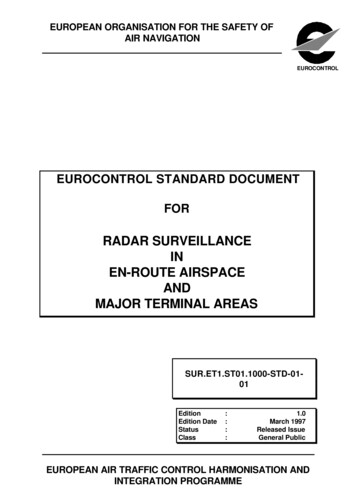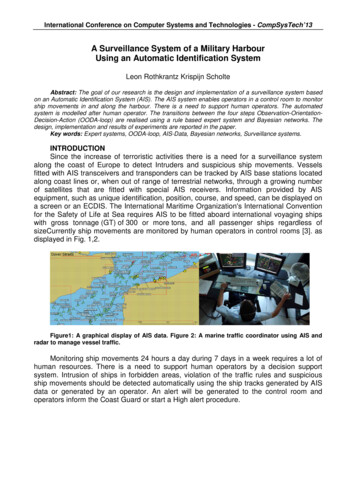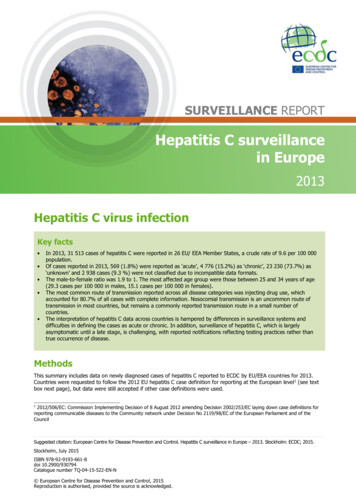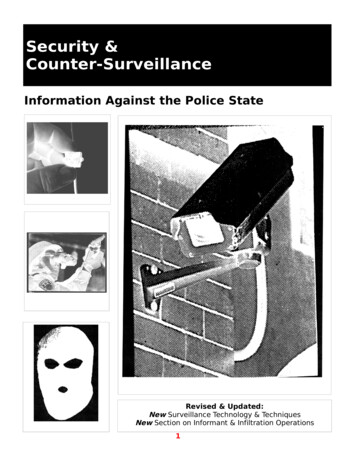
Transcription
Security &Counter-SurveillanceInformation Against the Police StateRevised & Updated:New Surveillance Technology & TechniquesNew Section on Informant & Infiltration Operations1
ContentsBig Brother is watching, more thanever before2009 edition; Vancouver, Canada/Coast Salish Territory1.Introduction 32. Surveillance33. Security34. Principles of Surveillance35. Physical Surveillance 4Operator's & Vehicles4Fixed Surveillance4Mobile Surveillance4Four Phases of Mobile 5Other Forms56. Technical Surveillance5Telecommunications5Listening Devices 6Parabolic Mics6Video Cameras 7Still Photography7Tracking Devices7Night Vision & Thermal7Biometrics 8UAV's8Satellite87. Surveillance Detection 9Physical Surveillance9Technical Surveillance 10Security Against Technical108. Surveillance and Evasion 139. Informants & Infiltrators13Dealing with/ 1510. FBI Cointel-Pro 16Cointel-Pro Techniques16Cointel-Pro Case Studies 1811. Case Studies of Informantsand Infiltrators 1812. Security Guidelines 19In countless ways, surveillance isemerging as the dominant way themodern world organizes itself.Britain now has an estimated 4.2 millionCCTV cameras—one for every 14 citizens.People in central London are now caught oncamera about 300 times a day.Surveillance is a condition of modernity,integral to the development of the nationstate and capitalism.More than ever before, our lives are visibleto others, from government agencies andsecurity services to the owners of thewebsites we surf and the stores where weshop. They track us in public, inworkplaces and online, compiling ourpersonal information in massive databasesand sorting us into categories of risk, valueand trustworthiness.CCTV cameras are just one of their tools.Others include radio frequencyidentification (RFID) chips, GPS locationtrackers, website cookies, facial recognitionsoftware and store loyalty cards. Computerprograms used by security services canmonitor and analyze billions of phone callsand e-mails in real time. We even make iteasier for our trackers by willinglydisclosing pieces of our lives on socialnetworking sites like Facebook or in onlinecontests & questionnaires.In one form or another, surveillance hasalways been a part of human society.What's new is computer technology thathas made it possible to integrate vast anddiverse bits of information. As well, ourpost-9/11 obsession with eliminating riskhas produced an architecture of masssurveillance in which everyone is treated asa suspect."Those in authority fear themask for their power partlyresides in identifying, stampingand cataloguing: in knowing whoyou are. our masks are not toconceal our identity but to revealit.”Don Butler, “Big Brother is watching, more than everbefore”, Vancouver Sun, Feb. 3, 2009Text on inside of 9,000 masksdistributed at the Carnival AgainstCapitalism, London, June 1999And for those who really are 'suspects', read on.2
1. Introductioncameras, in stores, banks, malls, offices, schools, transit, streets& intersections.In rural areas, physical surveillance is more oftennecessary due to the lack of telecommunications, roads, etc.Low population densities also serve to identify surveillanceoperators as ‘outsiders’.For these reasons, physicalsurveillance in rural areas often requires long-range observation(by ground teams, aircraft, or satellite in high prioritysituations). In some cases, police in military-style camouflagesecretly conduct surveillance at a much closer range.Security is vital to the success & survival of theresistance movement. This is because we have an enemy whoactively works to undermine, neutralize, & ultimately destroyus. Failure to remain aware of security concerns can mean thedifference between victory or defeat, freedom or imprisonment,life or death. Not only for yourself, but others around you.Information gathered from various sources, & that issubjected to analysis & comparison, is called intelligence. Thegathering of intelligence is a vital part of counter-insurgencyoperations, without which the enemy does not know who, what,where or when to strike.Security & Counter-Surveillance measures aredesigned to limit & deny the flow of information to enemyforces. It is based on the principle that counter-insurgency is apermanent part of society and that those engaged in resistanceare always vulnerable to surveillance & repression.3. SecuritySecurity n. 1. Measures adopted to guard against attack, theftor disclosure. 2. Something that gives or assures safety &confidence As noted, the purpose of security is to protect ourmovement. A vital part of this is to limit or deny the flow ofinformation to enemy forces. The following 4 principles shouldbe seen as basic & fundamental security guidelines:1. Do not send or discuss sensitive information overany form of telecommunications (phone, cell,internet, etc.), all of which are vulnerable tointerception. Cell Phones can be made into activelistening devices and should have their batteriesremoved before discussing any secret information.2. Never discuss sensitive information in any enclosedarea vulnerable to listening devices (i.e., homes,vehicles, cafes, etc.).3. Follow the Need-to-Know-Only Rule: If a person isnot involved in the information, then they do not needto know its contents. The less a person knows, the lessdanger there is they can tell others.4. Avoid those unable to follow basic security codes.They are a danger to you and the movement. Thisincludes persons who talk too much, who do not takesecurity seriously, alcoholics, etc.2. SurveillanceSurveillance is the continuous, secretive observation ofpersons, places, things or objects, in order to gain information.There are two types of surveillance: physical & technical.Physical surveillance is carried out by enemy personnelon foot and/or by vehicle. It is the only way a target person canbe continuously observed over an extended period of time.Surveillance teams can be comprised of two persons in onevehicle, or a dozen operators in six vehicles (or even more, ofcourse). In addition, motorcycles, bikes, planes & helicoptersmay also be used.In this category we must also consider informants,infiltrators & collaborators. They may be police agents,civilians recruited by police, or former comrades. This form ofphysical surveillance is the main source of intelligence onpeople’s thoughts, plans & activities. It is sometimes referredto as ‘human intelligence’. Because of the sensitive nature ofpersonal information they are able to gather, and their ability toinfluence events, infiltrators & informants are especiallydangerous.Technical surveillance is far more common. Withwidespread use of telecommunications (phone, cell, pager,internet, fax), technical surveillance is a main source ofintelligence on a person’s day to day activities, contacts,personal relationships, etc. More generally, it consists oftechnical devices to record, document or monitor a targetindividual’s movements, conversations, or activities. Thisincludes listening devices in homes & cars, tapped telephones,monitoring of internet activity, CCTV video, tracking devices,night-vision devices, etc.4. Principles of SurveillanceAs noted, surveillance is the secretive, continuouswatching of a person, place, vehicle, or object in order to gaininformation. In order to be effective, surveillance must gounnoticed and be undetected. As soon as the target is aware he/she is under surveillance, they will alter their behavior &conceal any ‘suspicious’ activities, as well as stop the flow ofinformation. For this reason, surveillance can be difficult todetect because it strives to be covert & hidden.Developing information through surveillance is aprogressive & often lengthy process. It is from many pieces ofinformation that an overall picture of the target’s patterns isdeveloped.Surveillance will normally begin with limitedinformation on a targeted individual’s activities, a residence orworkplace, etc. More info will be developed in order toidentify times, locations, routes of travel, or activities on whichThe urban environment is far more conducive tosurveillance, due to the large masses of people,communications & electrical systems, structures, & vehicles inwhich operators & devices can be concealed. In the city, thereare also tens of thousands of CCTV video3
Fixed Surveillanceto focus the surveillance effort (referred to as a target patternanalysis).The more extensive the surveillance effort, the greaterthe amount of intelligence produced. The extent of surveillancedepends upon the importance placed on the target by policeintelligence, and the target’s expected level of awareness &counter-surveillance knowledge (soft target vs. hard target).Just reading this manual can make you a harder target.Because of the resources & capabilities of our enemy,and its intent to monitor & repress rebellious tendencies (ofwhich we must assume we are a part of), surveillance againstour movements must always be considered as being possible (ifnot probable).Fixed surveillance (meaning it doesn't move) is set uparound a target’s home, a business, etc., to observe activities,patterns of movement, associations, or even to beginsurveillance of a target expected to appear at the location(stakeout). Another term for a fixed surveillance position isObservation Post (OP).It is usually conducted from overlooking positionssuch as hills, buildings, apartments, or vehicles parked in thearea. Fixed surveillance can change into mobile surveillancewith operators pre-positioned and ready to follow.****Rural: In a rural area, fixed surveillance can consist ofan armed reconnaissance team (police or military) taking uppositions from which it can observe the target location.Because this type of surveillance requires special fieldcraftskills (i.e., camouflage), it is most often conducted by speciallytrained police or military units. Another factor is the greaterlikelihood of firearms in rural areas (hunting rifles).Teams may set up OPs on overlooking hills ormountainsides, using hi-powered long-range cameras &telescopes, or in nearby forest, abandoned buildings, fields,bushes, etc.Operators may wear camouflage clothing,including 'ghillie suits', and construct camouflaged hidepositions (digging out an area large enough to lie in, setting upoverhead support, and covering it with the top layer of earth).5. Physical SurveillancePhysical surveillance is carried out by enemypersonnel (operators) on foot and/or by vehicle. It is the onlyway a target person can be continuously observed over anextended period of time. On foot or in a vehicle, operatorsmust keep their surveillance target in sight. A team assigned tomaintain this line-of-sight is said to have ‘command’ of thetarget. In order to avoid detection, the command is frequentlyshifted, so that no one operator or team is in direct sight of thetarget for too long a time (shifting command).Sophisticated surveillance efforts can involve manydifferent operators & vehicles. In such cases, teams aredeployed all around the target in a ‘floating box’ (in front, theback, sides, and on parallel routes).If physical surveillance is being carried out, then it canbe assumed that technical surveillance is also occurring, andmay have been for some time before physical surveillancebegan. This is because physical surveillance requires multipleoperators if it is to be succesful, and can be draining onpersonnel and resources.It's therefore possible thatsurveillance operators may have access to audio recordings ofthe target's conversations in a residence or vehicle, while theyare observing them.Mobile SurveillanceOnce a target person has been observed and is leavingthe location, the surveillance then becomes mobile. On foot orby vehicle, the target is followed until he/she stops. Asurveillance box is again set up with one operator having directline of sight on the vehicle or location (this is the trigger, whoalerts other operators as to actions of target).As the targeted individual re-appears on the move, thefixed surveillance box again transitions to a mobilesurveillance. In high-priority cases, the surveillance box willcover all known routes in and out of an area and can literallysurround the target.If a person drives, stops and walks around,surveillance vehicles will also drop off foot operators. Theywill then position themselves in a box around the target’svehicle, or assist in the foot surveillance by picking up anddropping off operators.For their part, foot operators may change jackets, hats,and other items of clothing in order to avoid detection. Oncedetected, they will be removed from the operation and replaced.Operators may also use bicycles if the target moves by bike orfoot.Rural: mobile vehicle surveillance in rural areaspresents some problems to operators due to the lack of cover onroads. Aerial surveillance can greatly assist, as can GPStracking devices (although they cannot say for certain whodrove the vehicle without some form of line of sightobservation). Nevertheless, rural mobile surveillance willfollow these basic patterns, with some modifications.Surveillance Operators & VehiclesSurveillance operators can be of any race, ethnicity,size, shape, etc., wearing any style of clothing, listening to anytype of music, etc. Not only are police & intelligence agentsused, so too are civilians & family members. They can be men,women, youth, or elders (i.e., the RCMP's 'Watchers' of theearly 1980s). Likewise, vehicles used by surveillance teamscan be of any model, year, condition, colour, etc. Appearanceby itself will rarely reveal a sophisticated surveillance effort.Instead, it is their activities which must be observed.In order to coordinate the efforts of many teammembers, communications body gear is worn by operators.This usually c
Surveillance Detection_9 Physical Surveillance 9 Technical Surveillance_10 Security Against Technical 10 8. Surveillance and . Surveillance operators can be of any race, ethnicity, size, shape, etc., wearing any style of clothing, listening to any type of music, etc. Not only are police & intelligence agents used, so too are civilians & family members. They can be men, women, youth .
